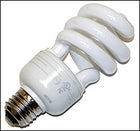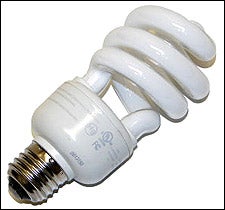WE’VE BEEN HEARING A LOT LATELY about those spiral-shaped, high-efficiency lightbulbs known as compact fluorescent lamps, or CFLs. Wal-Mart can’t get enough of ’em; the chain has pledged to sell more than 100 million this year. Al Gore put them at the top of his “ten things” list of ways you can combat global warming. Even Oprah has talked them up as a simple, affordable way to reduce your eco-footprint. The only people not getting excited about the quirky-looking fixtures, it seems, are American consumers.
Compact Fluorescent Lightbulbs

CFLs use up to 75 percent less energy than conventional incandescent bulbs, last up to ten times longer, and save between $25 and $45 over the life of the bulb. But despite their clear environmental and bottom-line benefits, only 5 percent of us are actually buying them. The resistance stems less from our environmental ignorance and more from our cultural obsession with quality of light.
Artificial lighting is a modern necessity: Americans, sadly enough, spend roughly three-quarters of their waking hours indoors. Whether it’s soft or severe, uplifting or unforgiving, indoor lighting influences our mood as much as the weather does. The difference between the warm, soothing tones of a candlelit dining room or a fireside den and the cold, punishing glare of a fluorescent-lit hospital or school cafeteria couldn’t be more dramatic.
The average American family buys approximately 20 bulbs a year, and our lighting choices are both habitual and nostalgic. Those teardrop-shaped incandescents that symbolize bright ideas use the same basic technology that Thomas Edison patented in 1880. “This is essentially your great-grandfather’s lightbulb,” says Jason Mathers, an Environmental Defense project manager who specializes in global-warming solutions. “In the age of MP3’s, you don’t see many people using century-old phonographs. So why are we still using ancient lighting technology?”
CFLs, which began hitting stores in the 1980s, offered new technology, but it was premature. Not only did the bulbs average about $30 a pop, but, like their traditional fluorescent ancestors, they flickered and buzzed and took their sweet time to illuminate fully. Worse, they threw off a wan, gray-blue light reminiscent of fleabag motels. They flopped.
But comparing the newest CFLs to the first ones on the market is like comparing current cell phones to those brick-size portables people lugged in the eighties. “There have been huge leaps and bounds in CFL technology since they were introduced,” says Kurt Riesenberg, a lighting-industry specialist at the National Electrical Manufacturers Association. “And yet most consumers still have the misunderstanding that those early glitches haven’t been solved.”
To grasp how much CFLs have improved, it helps to take a tour under the glass. Incandescents glow white-hot when electricity passes through a tungsten filament, but CFLs create light via a vapor: Electricity excites gaseous mercury particles inside the spiral tube, which causes the tube’s microthin phosphor coating to illuminate.
EARLY CFLS WERE ACTIVATED by intermittent signals that pulsed electricity 60 cycles per second, creating a hum and a subtle flicker that reportedly gave some consumers headaches. But newer CFLs, costing between $3 and $5 each, use a silent electronic mechanism that pulses 35,000 cycles a second, creating a steady glow that’s more like that of an incandescent. Engineers have also found ways to liven up CFLs’ sterile hue. While the phosphor coating on early models did a poor job of rendering color┬Śgiving off a cold, bluish light┬Śmany new models use an advanced phosphor substance to produce a look that’s closer to old-fashioned bulbs.
In fact, the light produced by CFLs and incandescents is now nearly identical. Scientists measure light’s color quality using two main factors: a Kelvin rating, which evaluates warmth, and a color rendering index (CRI), which indicates how light affects the appearance of color. The Kelvin rating for some of GE’s compact fluorescents matches that of corresponding incandescents, and while their CRI is slightly lower, this is virtually undetectable to the untrained eye. “The industry has done focus groups on consumer acceptance of CFL color,” says GE spokesperson Allison Ecklekamp. “It is very difficult to tell the difference between GE Energy Smart Bulbs and Soft White incandescent bulbs if you can’t see the lamp.” Russ Leslie, associate director at the independent Lighting Research Center at Rensselaer Polytechnic Institute, agrees. “Consumer resistance to CFLs is now mostly psychological,” he says.
Though it’s true that high-quality bulbs work and look better, cheaper models still on the market may use the old, sub-par technologies. How can you tell the difference? Look for Energy Star labeling┬Śsuch lights use three-quarters less energy than standard incandescents┬Śin boxes marked “soft white,” “pink,” or “daylight.” You also need to shop carefully for brightness. Because fluorescents create at least three times more lumens per watt than an incandescent does, you’ll find that a 15-watt CFL and a conventional 60-watt bulb are equally bright.
“The big hurdle for CFLs is getting consumers to select the right brand,” says Riesenberg. “If customers have a bad experience early on, you’re pretty much never going to get them back.” Wal-Mart is now installing what it calls “lightbulb education centers” in all its U.S. stores. GE, meanwhile, has rebranded its CFLs, removing “fluorescent” from the labels to call them simply “energy smart.”Why are GE and Wal-Mart investing in a low-priced, longer-life technology that, over time, will ultimately mean fewer sales? GE’s leaders figure the technology is unstoppable┬Śif they don’t lead the market, someone else will. Andy Ruben, Wal-Mart’s director of sustainability, is thinking along slightly different lines: “We see CFLs as the perfect starting point, the gateway that opens consumers up to the whole new frontier of sustainable products.” Once Wal-Mart customers grasp the benefits of green products, Ruben reasons, they’ll start buying organic cotton and produce, Energy Star washer-dryers, and other sustainable offerings that Wal-Mart is poised to sell.
Wal-Mart’s outreach is just one of several recent campaigns designed to push CFL technology into the mainstream. Yahoo’s 18 Seconds campaign┬Śnamed for the time it usually takes to change a lightbulb┬Śis seeding a CFL movement at a state level. OneBillionBulbs.com, a Web site launched last November by a Massachusetts software company, aims to convince the world to trade a billion incandescents for CFLs. The Coalition on the Environment and Jewish Life has taken up the cause, appealing to its constituents through a program titled “How Many Jews Does It Take to Change a Light Bulb?” Meanwhile, Australia’s energy minister, Malcolm Turnbull, has announced plans to phase out inefficient lighting in his country by 2010. Officials in California are debating similar bulb-banning efforts.
The fluorescent trend has its predictable detractors. Conservative pundit Rush Limbaugh, for one, has used his talk-radio pulpit to rail against “wacko activists” pushing CFLs. But when you consider the benefits of widespread CFL adoption, a state-based or federal program to encourage it doesn’t seem so crazy. If every American replaced one conventional bulb with a CFL, we’d keep 30 billion pounds of coal from being burned, and save more than $8 billion worth of energy. And that’s without sacrificing performance or quality of light. It’s the bright thing to do.


